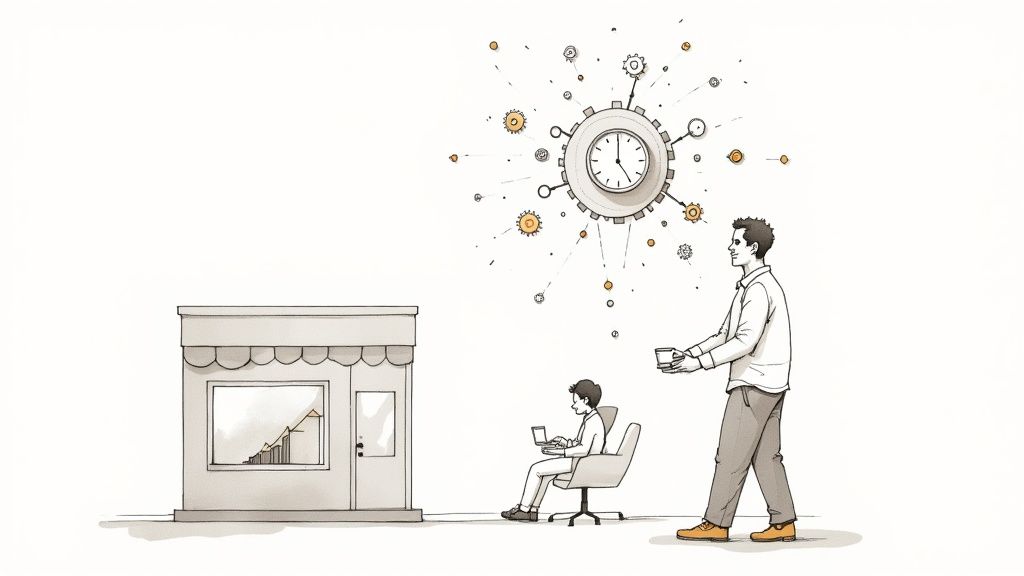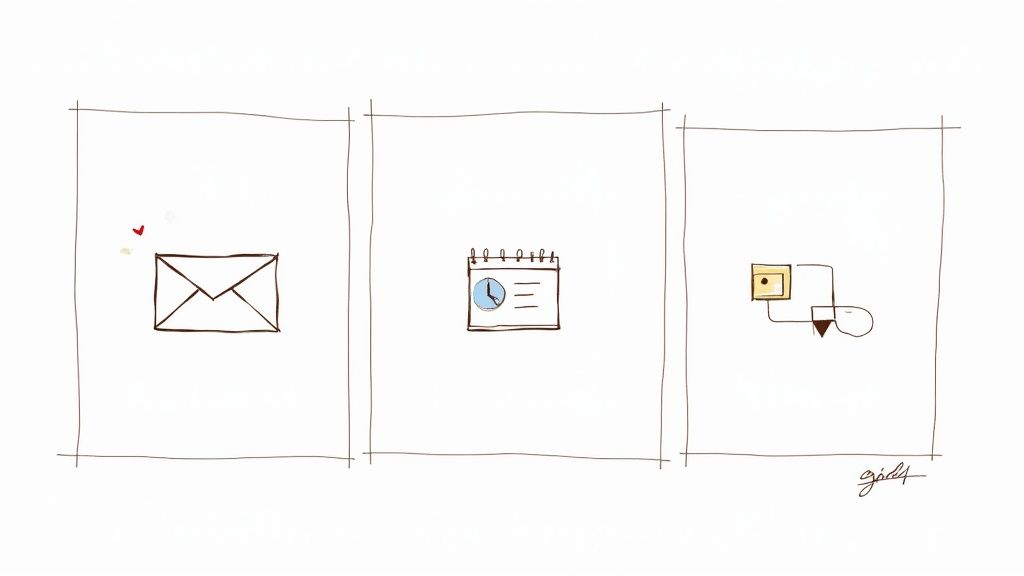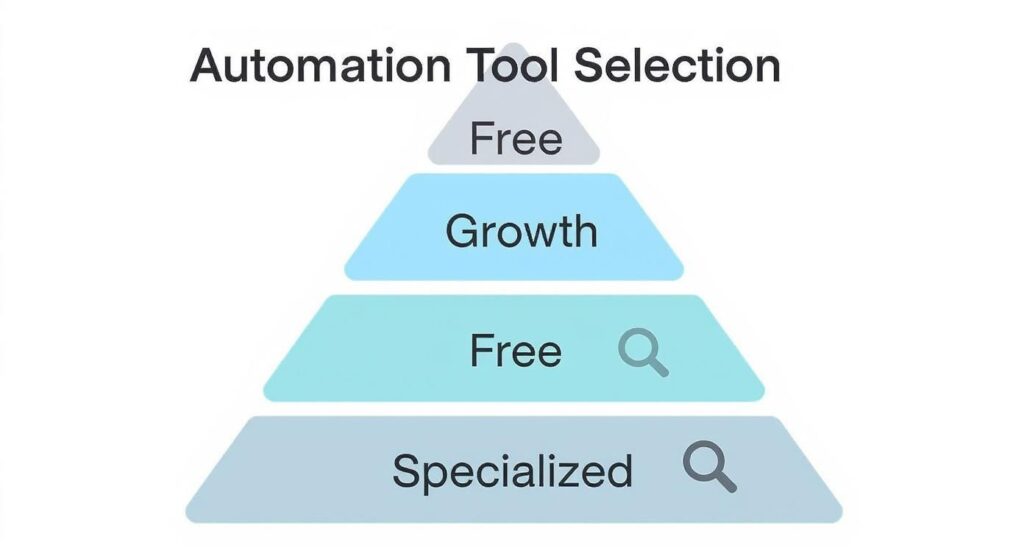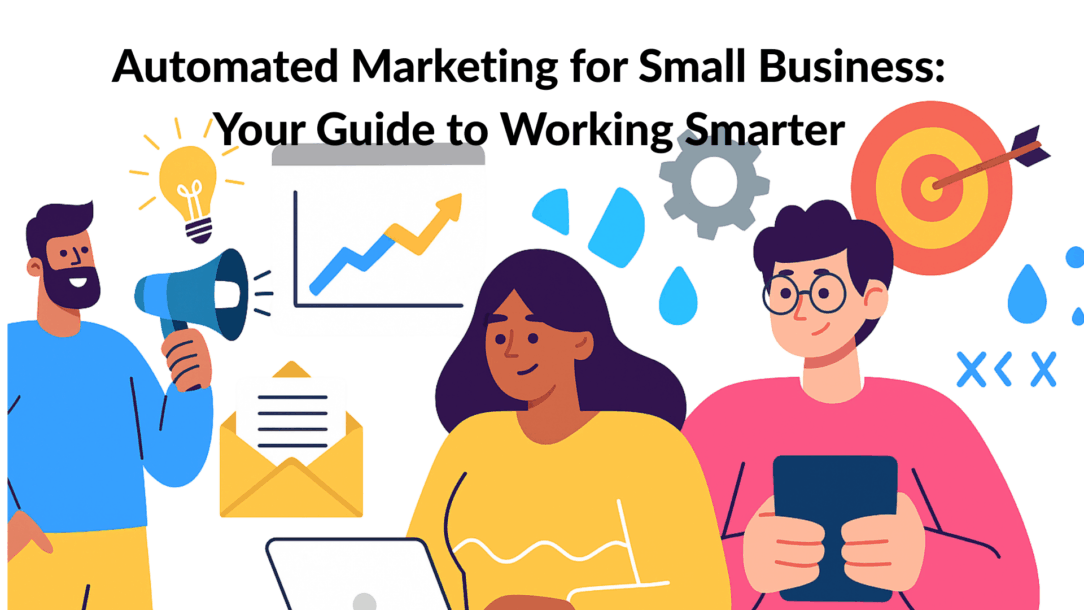Ever feel like you’re doing ten jobs at once? Managing inventory, serving clients, and still trying to find time to post on social media? If so, you’re not alone. Important tasks like sending thank-you emails or following up on leads often fall through the cracks.
This is where automated marketing for small business comes in. It’s not just software; it’s a digital assistant that handles your repetitive marketing tasks. It’s the engine that sends personalized emails, schedules social media content, and tracks customer interactions, freeing you up to focus on growing your business.
How Automation Transforms Your Small Business

automation is a game changer
For a small business, automation is more than a nice-to-have; it’s a game-changer. It’s like having an employee who works 24/7 without ever needing a coffee break.
This “digital team member” can send a warm welcome email the moment someone signs up. It can follow up with a potential customer who lingered on your pricing page. It can even remind a shopper about the items they left in their cart. These are the critical touchpoints that build relationships and drive sales—all without you lifting a finger.
Reclaim Your Most Valuable Asset: Time
The first and most immediate result of automation is the time it gives you back. All those small, repetitive tasks that eat up your day are handled automatically. You can finally stop manually exporting contact lists or scheduling dozens of social media posts one by one.
With that time back, you can focus on high-impact activities that truly grow your business, like:
- Developing new products or services your customers have been asking for.
- Building strategic partnerships with other local businesses.
- Providing exceptional customer service that turns one-time buyers into lifelong fans.
Automation isn’t about replacing the human touch; it’s about creating more time for it. By handling routine tasks, you’re free to focus on the personal interactions that set your business apart.
Deliver Personalized Experiences at Scale
Today’s customers expect to be recognized. They don’t want to feel like just another number on an email list; they want to feel understood. For a small team, this level of personalization can seem impossible, but automation makes it achievable.
You can segment your audience based on their behaviors, interests, and purchase history. For example, a local bakery can automatically send a birthday coupon for a customer’s favorite pastry. An online boutique can send style recommendations based on a shopper’s previous purchases.
These small, relevant interactions build powerful connections and keep customers coming back. This is how you create a memorable experience that larger competitors often can’t replicate.
Core Tasks Marketing Automation Handles
This table breaks down common manual jobs that automation can solve instantly, giving you a clear picture of its immediate value.
| Manual Task | Automated Solution | Business Impact |
|---|---|---|
| Welcome New Subscribers | Instantly send a personalized welcome email series. | Builds immediate engagement and sets expectations. |
| Follow Up on Leads | Trigger follow-up emails based on website activity. | Nurtures interest without manual tracking. |
| Social Media Posting | Schedule weeks of content in advance across platforms. | Ensures consistent brand presence and saves hours. |
| Recover Abandoned Carts | Automatically email reminders to shoppers who left items. | Recovers lost sales and boosts revenue. |
| Customer Segmentation | Group contacts based on purchases, location, or engagement. | Enables highly targeted and relevant marketing. |
By offloading these functions, you’re not just saving time—you’re building a smarter, more responsive marketing machine that works for you around the clock.
Essential Automation Strategies to Start Today

essential automation strategies
Jumping into marketing automation doesn’t require a huge budget or a team of tech experts. The key is to start with a few high-impact strategies that deliver immediate wins. These create a solid foundation you can build on later.
Forget trying to do everything at once. Focus on these simple but powerful tactics to turn your manual grind into consistent, reliable growth.
Craft an Automated Welcome Series
Your first interaction with a new subscriber is your most important one. An automated welcome email series ensures you make a great first impression every time, without any ongoing effort after the initial setup.
Think of it as your digital handshake. The moment someone joins your list, they should receive a warm greeting that introduces your brand, sets expectations, and guides them on what to do next.
A great welcome series can accomplish several goals at once:
- Tell Your Brand Story: A family-owned coffee shop could send an email sharing the founders’ passion for finding the best beans.
- Deliver Immediate Value: An online fitness coach could send a free workout video, showcasing their expertise from day one.
- Guide Them to a First Purchase: An e-commerce store selling handmade soaps could highlight its best-sellers in the final email of the sequence.
The most effective automated marketing doesn’t feel automated. A well-crafted welcome series makes each new subscriber feel personally greeted, building a strong connection from day one.
Schedule Your Social Media Content
Maintaining a consistent social media presence is crucial, but it can quickly become a full-time job. Social media scheduling tools are a game-changer, allowing you to plan and automate your posts weeks or even months in advance.
This transforms social media from a daily chore into a strategic activity. You can dedicate a single block of time to create all your content, then let the tool handle the rest. Your brand stays active and engaged, even while you’re busy running the business.
This strategy is widely adopted for a reason. A 2024 survey showed that about 49% of marketing decision-makers have automated their social media. You can learn more about the latest trends in business automation from Vena Solutions.
For example, a local restaurant can schedule its entire week’s posts on Monday morning: a “Taco Tuesday” promo, a behind-the-scenes video on Wednesday, and a preview of weekend specials on Friday. While the posts go live automatically, the owner is free to focus on the restaurant. This is also a perfect time to set up automated Instagram messaging to handle the replies and questions your scheduled posts generate.
Nurture Leads with Foundational Workflows
What happens after someone downloads your free guide or fills out a contact form? Without a plan, those warm leads can quickly go cold. A basic lead nurturing workflow automates the follow-up, turning initial interest into a real sales conversation.
This is where marketing automation truly shines. You can build a simple “if/then” workflow: if a visitor downloads your “Beginner’s Guide to Gardening,” the system automatically sends them a series of three emails over the next two weeks.
Here’s what a simple workflow could look like for a local real estate agent:
- Trigger: A user downloads the agent’s “Home Buyer’s Checklist.”
- Email 1 (Immediate): Delivers the checklist and says thanks.
- Email 2 (3 Days Later): Shares a blog post on “5 Common Mistakes First-Time Home Buyers Make.”
- Email 3 (7 Days Later): Asks if they have any questions and invites them to schedule a free consultation.
This automated sequence keeps the agent top-of-mind and provides value without any manual effort for each new lead, dramatically increasing the chance they’ll choose you when they’re ready to buy.
Choosing The Right Automation Tools For Your Budget
Stepping into marketing automation can feel overwhelming, like walking into a massive hardware store for the first time. The secret? Start with your actual needs and budget, not the flashiest features.
Choosing your first tool should be a strategic decision. A smart approach is to think in tiers, matching the software’s power—and price tag—to where your business is right now. This way, you pay for what you need today and have a clear path to upgrade when you’re ready.
Free and Freemium Starters
If you’re just dipping your toes in the water, this is your perfect starting point. Free and freemium tools are designed for small businesses that need to solve one or two specific problems without a big financial commitment. They are fantastic for testing automation and discovering what works for your audience.
These platforms provide the core features you need to see immediate value. Think of them as your entry-level toolkit, perfect for building good automation habits from day one.
- Email Marketing: A tool like Mailchimp’s free plan lets you build a list and set up an automated welcome email for new subscribers. It’s a simple but powerful first step.
- Social Media Scheduling: A platform like Buffer allows you to plan and schedule social media posts in advance, freeing you from the daily grind of manual posting.
The main trade-off is scale. You’ll eventually hit a limit on contacts or features, but these tools are the ideal way to get started with zero risk.
All-in-One Growth Platforms
Once you’ve mastered the basics and are ready to connect your marketing efforts, it’s time for an all-in-one platform. These systems are built for businesses that are serious about growth and want to manage everything from a single dashboard.
Instead of juggling multiple subscriptions, you get one integrated system where all your data works together. This gives you a much clearer picture of your customer’s journey from start to finish.
The real power of an all-in-one platform is consolidation. When your email marketing “talks” to your website forms and your lead management system, you can build smarter, more effective automation workflows.
For example, platforms like HubSpot Starter or ActiveCampaign are popular choices. A business using one of these could create a workflow where a visitor who fills out a form is automatically added to an email list, tagged based on their interest, and sent a targeted follow-up sequence. This is where you start seeing serious returns.
To find the right fit, it’s worth exploring a detailed guide on choosing a marketing automation tool for small business, which helps you compare features side-by-side.
Comparing Automation Platform Tiers
To help you identify the best starting point, here’s a quick feature and cost comparison.
| Platform Tier | Typical Cost | Core Features | Best For |
|---|---|---|---|
| Free/Freemium | $0 – $20/month | Basic email automation, social scheduling, simple forms | Solopreneurs and new businesses testing automation concepts. |
| All-in-One | $50 – $300/month | CRM, advanced email workflows, landing pages, analytics | Growing businesses ready to consolidate tools and scale marketing. |
| Specialized | $300+/month | Deep e-commerce integration, advanced analytics, custom workflows | Niche businesses or companies with very specific, complex needs. |
Each tier serves a purpose. The goal isn’t to jump to the most powerful tool, but to pick the one that solves today’s problems while giving you room to grow.
Specialized Power Tools
For some businesses, even a great all-in-one platform doesn’t quite cut it. This is where specialized tools come in. They are designed to solve very specific—and often complex—problems with an incredible degree of precision.
For instance, an e-commerce store might use a dedicated tool to create sophisticated abandoned cart sequences that include personalized product recommendations based on a shopper’s browsing history.
While these tools are often more expensive and have a steeper learning curve, they offer capabilities that can dramatically boost your bottom line. Before you commit to any tool, ask these three questions:
- Does this integrate with my existing systems? Your new tool must work with what you already use, like your website platform or CRM.
- What level of support is included? Good customer support is non-negotiable, especially when you’re learning.
- Is the pricing clear and scalable? Understand how the cost will change as your business grows to avoid surprises later.
Measuring Success with Metrics That Matter
Setting up marketing automation is a great first step, but it’s only half the journey. The real magic happens when you understand what’s working, what isn’t, and how your efforts impact your bottom line. Without the right metrics, you’re just flying blind.
It’s easy to get lost in data. Vanity metrics like social media likes or total email subscribers feel good, but they don’t always translate to revenue. Instead, focus on the numbers that prove your automation is fueling real, measurable growth.
Key Email Marketing Metrics
For most small businesses, email automation is the entry point and provides clear performance indicators. Don’t just look at open rates; dig deeper to see what people did after they opened your email.
These are the core metrics that reveal genuine interest and progress toward a sale:
- Click-Through Rate (CTR): The percentage of people who clicked a link in your email. A high CTR means your message was compelling.
- Conversion Rate: The percentage of people who completed your desired action after clicking, like making a purchase or filling out a form. This is your ultimate success metric.
- List Growth Rate: How quickly your email list is growing. A healthy rate shows your lead generation efforts are effective.
Tracking these numbers helps you fine-tune your approach. For a deeper dive, check out our guide on the top email marketing KPIs you should track for success.
Lead Generation and Customer Acquisition KPIs
Beyond email, your automation should be a lead-generating machine. Tracking lead generation KPIs helps you see how healthy your sales funnel is and what it costs to bring in new business.
The goal of automation isn’t just to keep you busy; it’s to make you profitable. When you track cost per lead and conversion rate, you stop just doing marketing and start making strategic, data-driven decisions.
Here’s what to keep an eye on:
- Cost Per Lead (CPL): Divide your total marketing spend by the number of new leads generated. A low CPL indicates efficient marketing.
- Lead-to-Customer Conversion Rate: The percentage of your leads that become paying customers. This measures both lead quality and the effectiveness of your sales process.
Calculating Your Marketing Automation ROI
Ultimately, every business investment must justify its cost. Calculating the return on investment (ROI) for your marketing automation provides the hard numbers to prove its value.
The formula is straightforward:
(Revenue Gained from Automation - Marketing Automation Cost) / Marketing Automation Cost
For instance, if you generated $10,000 in sales from automated campaigns and your software cost $1,000, your ROI is a massive 900%. This simple calculation reframes automation from an expense into a powerful revenue driver.
The infographic below helps visualize how to pick the right tools for your business, whether you’re starting with free options or looking for something more advanced.

automation tool selection
The data backs this up. Research consistently shows that marketing automation delivers a strong ROI. For every dollar spent, companies can expect an average return of $5.44 within three years, with many seeing their initial investment paid back in less than six months.
How AI Is Supercharging Small Business Marketing

AI supercharging small business marketing
If marketing automation is your digital assistant, then Artificial Intelligence (AI) is the super-smart upgrade that lets it think for itself. AI moves beyond simple “if this, then that” rules, giving your marketing the power to learn, predict, and even create.
It’s the difference between a tool that just follows instructions and one that generates brilliant ideas on its own.
For years, this power was out of reach for small businesses. Not anymore. Today, AI is integrated into many marketing tools, putting advanced capabilities into your hands. It’s no longer about complex algorithms; it’s about practical features that solve real-world problems and help you understand your customers on a much deeper level.
Deliver Smarter Personalization
Standard automation can add a customer’s name to an email. AI takes personalization to a new level by tailoring the entire experience to each individual’s behavior. It analyzes what they click, what they buy, and what they ignore to build a unique profile for every customer.
Think of it as a personal shopper for everyone who visits your site. AI can predict which products someone is most likely to want next and automatically feature them in an email or a website pop-up.
For example, an online store selling eco-friendly home goods could use AI to:
- Identify a customer who frequently buys kitchen supplies.
- Note their preference for bamboo products based on past purchases.
- Automatically send them a promo email featuring a new set of bamboo kitchen utensils the moment it’s available.
This is the kind of relevant, timely communication that makes customers feel understood and drives repeat sales.
Predict Which Leads Are Ready to Buy
Not all leads are created equal. Some are just browsing, while others are ready to buy. The key is knowing who to focus on.
AI solves this with predictive lead scoring. It’s a system that automatically ranks your leads based on their likelihood to make a purchase.
It works by analyzing thousands of data points—from how many times a lead visited your pricing page to whether they opened your last three emails. The AI then assigns each person a score, so your team can see at a glance who’s “hot” and who needs more nurturing.
AI doesn’t just automate tasks; it helps you make smarter decisions. By identifying your most promising leads, it ensures your sales team invests their energy where it will have the greatest impact, dramatically improving efficiency and closing more deals.
This is a game-changer. Instead of calling a massive list, your sales team can focus on conversations with people who are already showing strong buying signals, leading to a much higher success rate.
Create Marketing Content in Seconds
Writer’s block is a major productivity killer. Generative AI tools have become the ultimate creative sidekick, capable of drafting compelling copy for emails, social media posts, and ad campaigns in a flash.
You provide a simple prompt—like “write a fun Instagram caption for our new summer sandal collection”—and the AI generates multiple options to choose from and refine. It doesn’t replace your creativity; it jumpstarts it, saving you from staring at a blank page.
The adoption of these tools is exploding because they work. It’s clear that AI is quickly becoming a non-negotiable part of the automated marketing for small business toolkit.
Got Questions About Marketing Automation?
Jumping into marketing automation can feel like a big leap, and it’s normal to have questions. This section tackles the most common concerns we hear from business owners, providing clear, simple answers so you can move forward with confidence.
Ready to put these insights into action? Clepher gives you all the tools you need to build powerful, AI-driven chatbots for your website, Messenger, and Instagram. Start turning conversations into customers and automate your growth today. Explore Clepher and see what’s possible.
Related Posts



